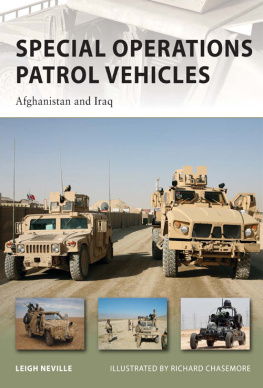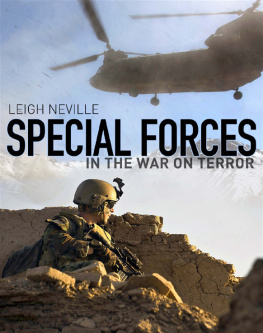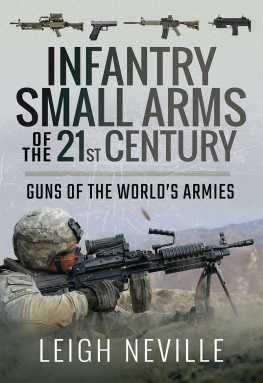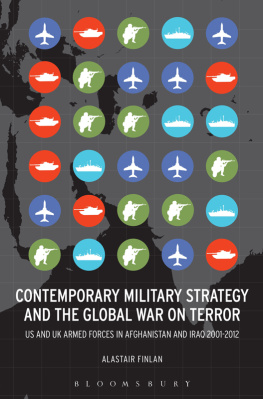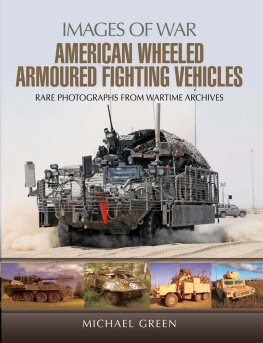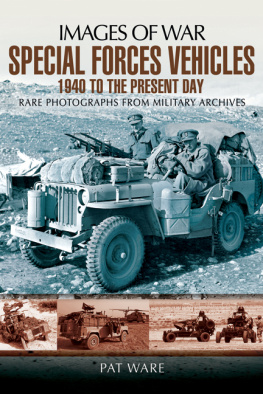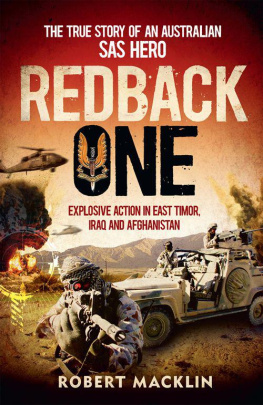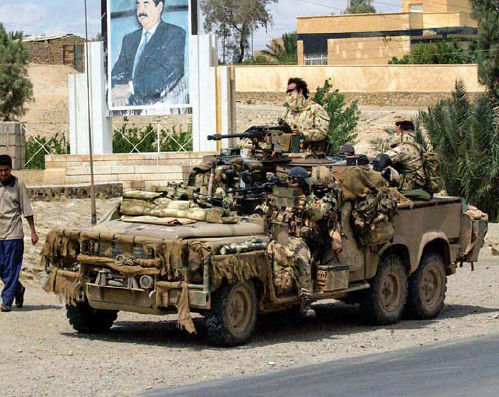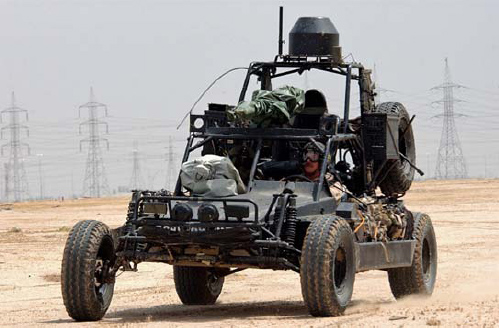NEW VANGUARD 179
SPECIAL OPERATIONS PATROL VEHICLES
Afghanistan and Iraq
LEIGH NEVILLE ILLUSTRATED BY RICHARD CHASEMORE
CONTENTS
SPECIAL OPERATIONS PATROL VEHICLES
AFGHANISTAN AND IRAQ
INTRODUCTION
Special Operations Forces (SOF) have a long history of the use of specialist or customized vehicles adapted to match the unique requirements of their unconventional missions. In the Western Desert during World War II, the Long Range Desert Group (LRDG) used often gaudily camouflaged, and heavily armed, Chevrolet 30cwt trucks alongside machine-gun equipped Willys Jeeps on special reconnaissance (SR) missions. The units colleagues in the fledgling Special Air Service (SAS) also pioneered the use of the Gun Jeep. The SAS mounted daring airfield raids, destroying German aircraft on the ground, and became a major hindrance to Rommels forces, whilst also proving that raids using specialist armed vehicles were a valid SOF tactic. The LRDG and SAS also developed the concept of what were later termed mother-ships medium to heavy transport trucks driven far behind enemy lines to act as mobile resupply points, allowing the SOF to undertake longer patrols without recourse to traditional resupply channels.
Later in the war, in Europe, the SAS continued with the successful employment of armed Jeeps, adding further field modifications that included crude ballistic glass and light armor, effectively producing a very early precursor to todays heavily armored High-Mobility Multi-Purpose Wheeled Vehicle (HMMWVs; Humvees). The US Army made extensive use of both armed and armored Jeeps for reconnaissance duties by conventional forces and by the Rangers in the European theater (the Rangers also utilized so-called Machine-Gun Jeeps in combat patrols during the Korean War).

An Australian SASR LRPV deployed in Iraq in 2003. This vehicles four-man crew is typically well armed, with the main .50 M2, forward-mounted FN MAG 58, Javelin ATGM (just visible in its casing to the left of the rear crew member), and camouflage-painted 7.62x51mm SR-25 sniper rifle strapped to the hood in front of the driver. What appears to be a snipers drag bag is seen just ahead of the SR-25 and may contain a second sniper rifle, possibly a .50 AW-50 or Barrett. (Courtesy ADF SOCOMD)
Postwar, SAS operations in Oman saw the revival of the concept in the form of a number of Series One Land Rovers modified to mount twin Vickers medium machine-guns (MMGs) and a pair of Browning .30 MMGs for deployment on recce missions. (Note that recce is the abbreviation for reconnaissance used in both British and American Tier One SOF terminology, as opposed to the more common American or Australian recon.) The legendary SAS Pink Panther a heavily customized Land Rover 109 that gained its nickname from the pink tone initially used as remarkably effective camouflage paint was first deployed in the late 1960s during the SASs counterinsurgency operations in Aden. The 109 allowed longer-range operations due to its increased payload capacity and additional fuel tanks, and was more heavily armed through the integration of the big Browning M2 .50 heavy machine-gun (HMG). The Pink Panthers became as much an icon of the SAS as Jeeps were during the campaigns in the Western Desert. They continued to serve with distinction until the late 1980s, when they were replaced by new model SAS Landies the Land Rover 110 Desert Patrol Vehicle (DPV). However, even with the adoption of the new model DPV, the nickname Pinkie stuck.
The US and Australian militaries were also developing similar platforms for their SOF during the 1960s and 1970s. The US Army Rangers famously used their M151 Gun Jeeps with mounted single or twin M60 General Purpose Machine-Guns (GPMGs), as did infantry and mechanized scout platoons in Vietnam, where the vehicles often served as convoy escorts for supply columns, speeding to position and suppressing ambushes. The Ranger Gun Jeeps were later to deploy to Grenada during Operation Urgent Fury in 1983 and subsequently to Panama during Operation Just Cause in 1989.
The Australians followed the UK Special Forces (UKSF) example for their Special Air Service Regiment (SASR), and modified Land Rover Series 2As as the Long Range Patrol Vehicle (LRPV), before eventually adopting the now famous six-wheeled Jaguar Perentie LRPV. The SASR had the unenviable task of conducting long-range reconnaissance and surveillance operations in Australias barren far north and their vehicles were suitably enhanced for the grueling conditions. Such experience, and that of 22 SAS in Oman and Aden, would still be extremely pertinent decades later in Iraq and Afghanistan.
The next major evolution in SOF vehiclemounted operations occurred during the 1991 Operation Desert Storm to liberate Kuwait after Iraqi forces invaded the tiny, oil-rich nation. US and UK SOF deployed in the infamous Scud Hunt for Iraqi Scud ballistic missile platforms, aiming to inhibit Iraqs capability to launch missiles into Saudi Arabia, Israel, and Bahrain. Both 1st Special Forces Operational Detachment Delta (SFOD-D or Delta) and Operational Detachment Alpha (ODA) teams from the 5th Special Forces Group (Airborne) conducted long-range SR mounted and foot patrols to uncover the Scud launchers and call in Coalition airstrikes. Some of these operations utilized so-called Special Forces Desert Mobility Vehicles (DMVs), early variants of which would later become known as Ground Mobility Vehicles (GMVs). These were standard M998 and M1026 HMMWVs enhanced with integrated specialist communications, improved suspension, and increased cargo capacity and weapons stations (apparently some Land Rover-based vehicles were also modified and used by Delta during the campaign). The UKSF contribution from 22 SAS included recently acquired 110 DPVs, supported by Unimog and ACMAT trucks acting as mother-ships, in turn protected by a number of modified Defender 90 Land Rovers.
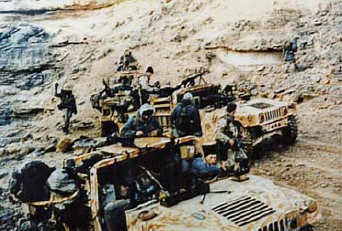
An exceedingly rare image of the original DMV HMMWVs in use by Delta in the 1991 Gulf War. Despite its poor resolution, the image shows the extensively modified early M998 and M1026 versions. Of particular interest is the apparent lack of heavy crewserved weapons mounted on the two vehicles in the foreground, with M249s and M60s apparently the extent of their armament. The rear vehicle appears to mount an M2 .50 in some form of ring mount, but the image is not clear enough to identify the vehicle it may well be a Land Rover variant. (Courtesy USSOCOM)
The famed US Navy SEAL DPV shown deployed in southern Iraq. Both weapons visible on this three-man version are covered to protect against the sand. (Courtesy US Navy, photo by Photographers Mate 1st Class Arlo Abrahamson)
In addition, the Gulf War saw the operational debut of a new concept in SOF vehicles known variously as the Light Strike Vehicle (LSV) in UKSF service or as the Desert Patrol Vehicle (DPV) in US Navy service. Essentially an upgraded, armed, two- or three-seat dune buggy, the LSV was operationally trialed by 22 SAS in Iraqs western deserts, found wanting, and quickly retired, although the US Navy SEALs (Sea, Air and Land teams) adopted the DPV and were famously photographed as they drove several of the vehicles into Kuwait City at the conclusion of the ground campaign.
Next page
